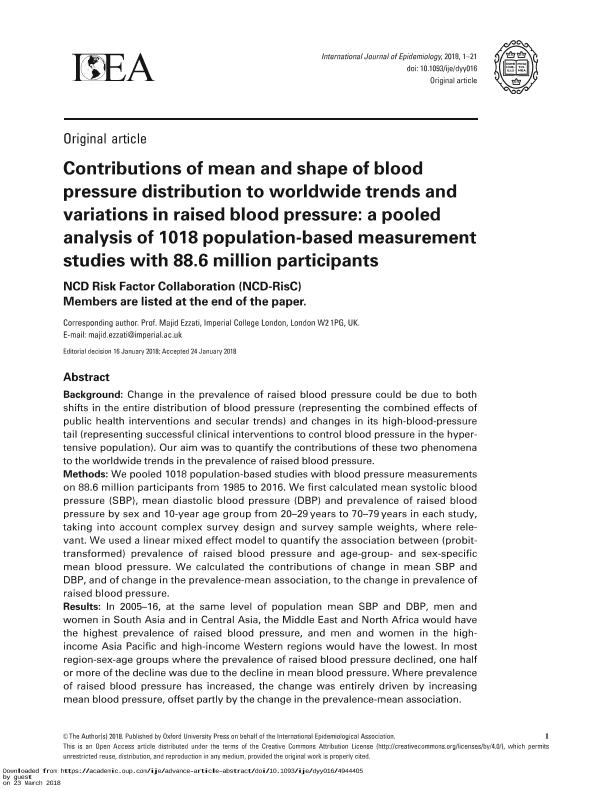Mostrar el registro sencillo del ítem
dc.contributor.author
Diaz, Alberto Alejandro

dc.date.available
2020-08-13T15:48:42Z
dc.date.issued
2018-11
dc.identifier.citation
Diaz, Alberto Alejandro; Contributions of mean and shape of blood pressure distribution to worldwide trends and variations in raised blood pressure: a pooled analysis of 1018 population-based measurement studies with 88.6 million participants; Oxford University Press; International Journal of Epidemiology; 47; 3; 11-2018; 1-21
dc.identifier.issn
0300-5771
dc.identifier.uri
http://hdl.handle.net/11336/111644
dc.description.abstract
Background: Change in the prevalence of raised blood pressure could be due to bothshifts in the entire distribution of blood pressure (representing the combined effects ofpublic health interventions and secular trends) and changes in its high-blood-pressuretail (representing successful clinical interventions to control blood pressure in the hypertensivepopulation). Our aim was to quantify the contributions of these two phenomenato the worldwide trends in the prevalence of raised blood pressure.Methods: We pooled 1018 population-based studies with blood pressure measurementson 88.6 million participants from 1985 to 2016. We first calculated mean systolic bloodpressure (SBP), mean diastolic blood pressure (DBP) and prevalence of raised bloodpressure by sex and 10-year age group from 20?29 years to 70?79 years in each study,taking into account complex survey design and survey sample weights, where relevant.We used a linear mixed effect model to quantify the association between (probittransformed)prevalence of raised blood pressure and age-group- and sex-specificmean blood pressure. We calculated the contributions of change in mean SBP andDBP, and of change in the prevalence-mean association, to the change in prevalence ofraised blood pressure.Results: In 2005?16, at the same level of population mean SBP and DBP, men andwomen in South Asia and in Central Asia, the Middle East and North Africa would havethe highest prevalence of raised blood pressure, and men and women in the highincomeAsia Pacific and high-income Western regions would have the lowest. In mostregion-sex-age groups where the prevalence of raised blood pressure declined, one halfor more of the decline was due to the decline in mean blood pressure. Where prevalenceof raised blood pressure has increased, the change was entirely driven by increasingmean blood pressure, offset partly by the change in the prevalence-mean association.Conclusions: Change in mean blood pressure is the main driver of the worldwide change inthe prevalence of raised blood pressure, but change in the high-blood-pressure tail of thedistribution has also contributed to the change in prevalence, especially in older age groups.
dc.format
application/pdf
dc.language.iso
eng
dc.publisher
Oxford University Press

dc.rights
info:eu-repo/semantics/openAccess
dc.rights.uri
https://creativecommons.org/licenses/by-nc-sa/2.5/ar/
dc.subject
EPIDEMIOLOGY
dc.subject
BLOOD PRESSURE
dc.subject.classification
Epidemiología

dc.subject.classification
Ciencias de la Salud

dc.subject.classification
CIENCIAS MÉDICAS Y DE LA SALUD

dc.title
Contributions of mean and shape of blood pressure distribution to worldwide trends and variations in raised blood pressure: a pooled analysis of 1018 population-based measurement studies with 88.6 million participants
dc.type
info:eu-repo/semantics/article
dc.type
info:ar-repo/semantics/artículo
dc.type
info:eu-repo/semantics/publishedVersion
dc.date.updated
2020-05-11T19:21:37Z
dc.journal.volume
47
dc.journal.number
3
dc.journal.pagination
1-21
dc.journal.pais
Reino Unido

dc.journal.ciudad
Oxford
dc.description.fil
Fil: Diaz, Alberto Alejandro. Consejo Nacional de Investigaciones Científicas y Técnicas. Centro Científico Tecnológico Conicet - Tandil; Argentina. Universidad Nacional del Centro de la Pcia.de Bs.as.. Escuela Superior de Ciencias de la Salud. Instituto de Investigación En Ciencias de la Salud.; Argentina
dc.journal.title
International Journal of Epidemiology

dc.relation.alternativeid
info:eu-repo/semantics/altIdentifier/doi/http://dx.doi.org/10.1093/ije/dyy016
dc.relation.alternativeid
info:eu-repo/semantics/altIdentifier/url/https://academic.oup.com/ije/article/47/3/872/4944405
Archivos asociados
